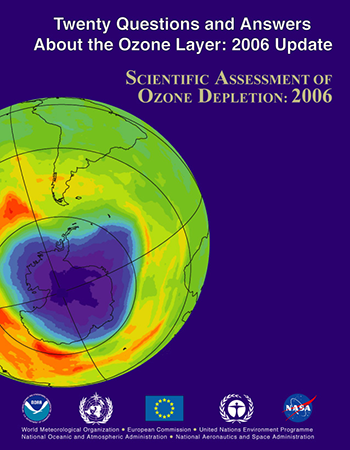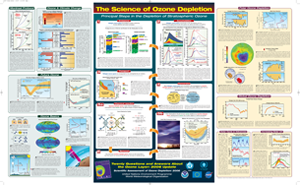A .gov website belongs to an official government organization in the United States.
A lock () or https:// means you've safely connected to the .gov website. Share sensitive information only on official, secure websites.

Ozone is a very small part of our atmosphere, but its presence is nevertheless vital to human well-being.
Most ozone resides in the upper part of the atmosphere. This region, called the stratosphere, is more than 10 kilometers (6 miles) above Earth's surface. There, about 90% of atmospheric ozone is contained in the "ozone layer," which shields us from harmful ultraviolet light from the Sun.
However, it was discovered in the mid-1970s that some human-produced chemicals could destroy ozone and deplete the ozone layer. The resulting increase in ultraviolet radiation at Earth's surface may increase the incidences of skin cancer and eye cataracts.
Following the discovery of this environmental issue, researchers focused on a better understanding of this threat to the ozone layer. Monitoring stations showed that the abundances of the ozone-depleting chemicals were steadily increasing in the atmosphere. These trends were linked to growing production and use of chemicals like chlorofluorocarbons (CFCs) for refrigeration and air conditioning, foam blowing, and industrial cleaning. Measurements in the laboratory and the atmosphere characterized the chemical reactions that were involved in ozone destruction. Computer models employing this information could then predict how much ozone depletion was occurring and how much more could occur in the future.
Observations of the ozone layer showed that depletion was indeed occurring. The most severe and most surprising ozone loss was discovered to be recurring in springtime over Antarctica. The loss in this region is commonly called the "ozone hole" because the ozone depletion is so large and localized. A thinning of the ozone layer also has been observed over other regions of the globe, such as the Arctic and northern middle latitudes.
The work of many scientists throughout the world has provided a basis for building a broad and solid scientific understanding of the ozone depletion process. With this understanding, we know that ozone depletion is occurring and why. And, most important, we know that if ozone-depleting gases were to continue to accumulate in the atmosphere, the result would be more depletion of the ozone layer.
In response to the prospect of increasing ozone depletion, the governments of the world crafted the 1987 United Nations Montreal Protocol as a global means to address this global issue. As a result of the broad compliance with the Protocol and its Amendments and Adjustments and, of great significance, industry's development of "ozonefriendly" substitutes for the now-controlled chemicals, the total global accumulation of ozone-depleting gases has slowed and begun to decrease. This has reduced the risk of further ozone depletion. Now, with continued compliance, we expect recovery of the ozone layer by the late 21st century. The International Day for the Preservation of the Ozone Layer, 16 September, is now celebrated on the day the Montreal Protocol was agreed upon.
This is a story of notable achievements: discovery, understanding, decisions, actions, and verification. It is a story written by many: scientists, technologists, economists, legal experts, and policymakers. And, dialogue has been a key ingredient.
To help foster a continued interaction, this component of the Scientific Assessment of Ozone Depletion: 2006 presents 20 questions and answers about the often-complex science of ozone depletion. The answers are updates of those first presented in the previous ozone Assessment, Scientific Assessment of Ozone Depletion: 2002. The questions address the nature of atmospheric ozone, the chemicals that cause ozone depletion, how global and polar ozone depletion occur, and what could lie ahead for the ozone layer. A brief answer to each question is first given in italics; an expanded answer then follows. The answers are based on the information presented in the 2006 and earlier Assessment reports. These reports and the answers provided here were all prepared and reviewed by a large international group of scientists1.
1. The update of this component of the Assessment was discussed by the 77 scientists who attended the Panel Review Meeting for the 2006 Ozone Assessment (Les Diablerets, Switzerland, 19-23 June 2006). In addition, subsequent contributions, reviews, or comments were provided by the following individuals: S.A. Montzka (special recognition), R.J. Salawitch (special recognition), D.L. Albritton, S.O. Andersen, P.J. Aucamp, M.P. Baldwin, A.F. Bias, G. Bodeker, J.F. Bornman, G.O. Braathen, J.P. Burrows, M.-L. Chanin, C. Clerbaux, M. Dameris, J.S. Daniel, S.B. Diaz, E.G. Dutton, C.A. Ennis, V. Eyring, V.E. Fioletov, N.P. Gillet, N.R.P. Harris, M.K.W. Ko, L. Kuijpers, G.L. Manney, R.L. McKenzie, R. Müller, E.R. Nash, P.A. Newman, T. Peter, A.R. Ravishankara, A. Robock, M.L. Santee, U. Schmidt, G. Seckmeyer, T.G. Shepherd, R.S. Stolarski, W.T. Sturges, J.C. van der Leun, G.J.M. Velders, D.W.Waugh, C.S. Zerefos.

OZONE IN OUR ATMOSPHERE
THE OZONE DEPLETION PROCESS
STRATOSPHERIC OZONE DEPLETION
CONTROLLING OZONE-DEPLETING GASES
IMPLICATIONS OF OZONE DEPLETION
STRATOSPHERIC OZONE IN THE FUTURE
ADDITIONAL TOPICS
Technical Note: The graphics and powerpoint files included on the distributed CD contained errors.
For all users, some problems were discovered with the Twenty Questions and Answers PowerPoint files on the CD, located in the folder titled "Q&A Figures." New PowerPoint files are available here on the Twenty Questions and Answers About Ozone: 2006 Update webpage. Alternatively, Windows users may successfully insert the jpeg files on the CD into PowerPoint files.
Additionally for Mac users, some problems were discovered with many of the jpeg files for both the Twenty Questions and Answers and Chapters, especially when importing into PowerPoint. If experiencing any problems with a jpeg file, select one of two ways to obtain a useable jpeg. 1) Download the figure from the collection of chapter figures webpage. 2) Correct the jpeg with the following procedure... Open the jpeg file into Preview and save it as a PDF file. The resulting pdf file may be inserted into PowerPoint, or used like any other pdf file.